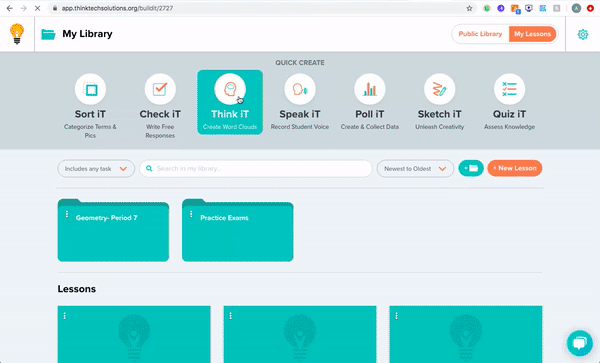How do I make a Think iT?
- Start by filling out the required fields including title, grade level, and subject.
- Next, write out a question, prompt, or idea that can be bolded, underlined, and highlighted.
- You can also upload media including an image, PDF, YouTube video, or math equation to support the question.
- Once the question is complete, hit start to launch your lesson and share the lesson ID with your class to allow them to participate.

What can I use a Think iT for?
Bell ringer– Have a prompt waiting for students as they enter the class that asks them to donate their prior knowledge, brainstorm around a topic, or highlight essential vocabulary
Whole class discussion– Have students donate their thoughts around a given prompt or question that is tied directly to any content you desire. The responses will produce a visual that will spark insightful conversations and allow you to foster accountable talk with endless possibilities.
Vocabulary– Create the ultimate visual for students by asking them to donate their thoughts around an image or piece of text. Ask students to reflect on the word cloud that has been produced and explore unfamiliar words. Partner with Sketch iT, and allow students to note make visuals to help learn newly identified vocabulary.
Reading comprehension– Word clouds can be a powerful way to assess and measure reading comprehension. Give students a sense of ownership by having them read through a selected text and identify key vocabulary, main ideas, and concepts to compare and contrast with the teacher’s model. Students can now reflect on their own learning and identify their own misconceptions.
End of class activity– Use Think iT to close your lesson by asking students to review the material covered and identify key terms, concepts, and big ideas. Download the newly produced word cloud as an image and have students save it to their files for instant note making.
How can I use Think iT in an English classroom?
- Put up an image or photo of a symbol connected to a piece of literature. For example, a 10,000 check for A Raisin in the Sun. Have students brainstorm what they could buy with 10,000 dollars as a way to connect to one of the main characters, Walter.
- Present a setting (either specific to a text or generic like “a school”) For example, 1920’s New York for The Great Gatsby. Encourage students to brainstorm things they associate with that setting as an anticipation guide.
- Have students brainstorm different terms for Tone, Mood, etc. Teachers can create posters that are generated from student ideas for their classroom.
How can I use Think iT in a Science Classroom?
- When studying genetics, have students brainstorm which traits they believe to be hereditary and inherited.
- Put a photo of water, or a prompt up, and ask students to brainstorm the role of water in the Earth’s surface processes.
- Activate prior knowledge at the beginning of each unit by creating a word cloud to show what students know about a topic. Ex: Put up an ecosystem and have students brainstorm what organisms, physical features, biotic factors are associated with that ecosystem.
How can I use Think iT in a Math Classroom?
- After students read a problem that involves new domain specific vocabulary, create a word cloud on terms that are difficult for students to understand in order to determine where students need more instruction.
- Have students determine what a key word in a question is. The bigger the word becomes demonstrates which term students believe is the key word. Depending on whether this is correct or not, teachers will know which problems to focus on for assessments and instruction.
- Place a problem for all students to see. Students can determine which formula would be used to solve a problem, which property is being displayed, etc.
How can I use Think iT in a Social Studies Classroom?
- Upload a picture of a region (such as India) and have students brainstorm as many terms or words associated with that region. This will activate prior knowledge, or show misconceptions to the class. The words can later be used in Sort IT and categorized.
- Have students determine what a key word in a question (similar to one they’d see on an exam) is. The bigger the word becomes demonstrates which term students believe is the key word. Depending on whether this is correct or not, teachers will know which questions to focus on for assessments and instruction.
- Put up a picture of something that was key to the growth of an empire/region. Have students brainstorm how this benefitted a culture. (Ex: Aqueducts, roads, paper, etc.).






Leave a Reply
You must be logged in to post a comment.